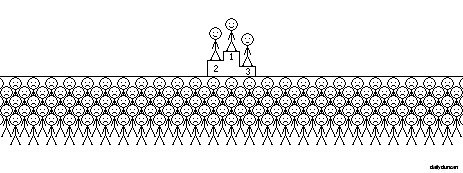If your goal was to own the fastest Mercedes-Benz sedan, which of the following would you most prefer?
- S
- SL
- SLK
- SLS
- E
- C
- CL
- CLA
- CLS
The correct answer is the SLS, which takes a short 3.8 seconds to accelerate from 0 to 100 km/h. Although this fact may be common knowledge to motor enthusiasts, neither the vehicle’s speed nor any other attribute can be inferred from the model name alone. This isn’t surprising, since automobiles generally do not derive their name from specifications. However, this may cause some to wonder why a company would create a system of letters and numbers to identify their products, yet avoid using those letters and numbers to describe them.
There are generally two approaches to naming products. The first is to assign product names individually, as is commonly done with with pets and children. Automobile names are usually taken from an animal, location or native tribe in an attempt to summon imagery of strength, prestige and speed in the minds of consumers. Although the name may not describe any of the vehicle’s specifications, it usually embodies some of its characteristics.
The Dodge Magnum, for example, gives the impression of a powerful, dangerous weapon, while the Ford Fiesta’s title implies that driving the car is like having a party. There are cases where the vehicle’s title doesn’t quite fit, as it did with the Dodge Shadow, which is in no way a dark or sinister machine. In fact, the Plymouth Sundance, despite having nearly the complete opposite name as the Shadow, is actually the same vehicle.
There isn’t anything wrong with using individual names, other than the fact that they usually don’t communicate any significant information about the product. This brings us to the second option.
The other route to naming products is to implement a system of alphanumeric codes. Although products named in this fashion lack the unique symbolism of an individual name, there are several significant advantages to this method. First, the release of each new model does not require the creation of a name. Second, these names sound technical and cool. Finally, and most importantly, key product information can be easily deciphered from these codes, but only if the codes are implemented with care.
Product codes may reflect one or more of the product’s traits, including release date, size, speed, color or series. BMW, for example, names its vehicles with a three digit number, followed by one or two letters. The first digit of the number represents the vehicle’s series, which describes the body size and other details. The following two digits indicate performance, and the letters describe various options, including automatic transmission, fuel injection or a convertible roof.
One mistake that those at BMW made when they conceived of this system was that they limited their capacity to release new series of vehicles. By using single digit numbers, BMW essentially proclaimed that they would never introduce more than two models smaller than the 3 series, and no more than one model between the 3 and 5 or 5 and 7 series. Although there have been changes, additions and exceptions to the BMW codification, their system remains a useful and straightforward example of the implementation of product codes.
There are many examples of product codes that do more to confuse than to educate. Nvidia’s GeForce line of computer graphics cards have suffered from a lack of clear and consistent product coding. In modern GeForce codification, the first digit of the model number represents the generation, while the remaining numbers indicate performance. There is usually a prefix, a suffix or both a prefix and suffix attached to the model number, which also indicates performance.
Although the model numbers, prefixes and suffixes do have meaning, the actual specifications of the product are impossible to extract from the product code alone. For example, the GTX 690 has double the amount of memory of the 680, but the 680 has the same memory as the 670. To cause further confusion, the 680 model also has a higher clock speed than the 690, which was touted as the most powerful card in the 600 series.
Now aside from using an inconsistent system for identifying individual products, the many generations of GeForce graphics cards have not been named in the same way. The first generation was strangely named the GeForce 256, which was succeeded by the GeForce 2. The GeForce 3 and 4 followed, but then the numeric succession was interrupted by the GeForce FX. The coding then returned to the previous pattern with the releases of the GeForce 6, 7, 8 and 9. However, when Nvidia announced its 10th generation of graphics cards, there was an adjustment. Since the 4th generation, most of the model numbers had been four digits long, which meant that the 10th generation would roll them over to a five digit number. To avoid such extensive product codes, the 10th generation was christened the 100 series. Since then, each generation has added 100 to previous generation’s code.
Another possible area of confusion is that series and model names are often largely arbitrary. In the examples above, the numbers don’t actually represent anything other than the relation between products, which isn’t even proportionally accurate. To avoid this, Samsung coded its televisions according to the size of the screen, the type of display and the number of features. By linking product codes to actual, meaningful specifications, Samsung’s products may all be easily identified by their product code.
When planning to implement a system of codes for products, whether for inventory or product naming purposes, be sure to follow these simple rules:
- Have your codes represent key product information.
- Leave room for new codes.
- Be consistent.
- Don’t use the letter X.
Ideally, product codes should include the greatest amount of relevant information that can be conveyed while remaining concise and legible. As an exercise, examine the following examples of product names:
- Nintendo
- Nintento Entertainment System (NES)
- Super Nintendo Entertainment System (SNES)
- Nintendo 64 (N64)
- Gamecube (GCN)
- Wii
- Wii U
- Sony
- Playstation (PS1)
- Playstation 2 (PS2)
- Playstation 3 (PS3)
- Playstation 4 (PS4)
- Microsoft
- Xbox
- Xbox 360
- Xbox One
Now try to determine which of these companies has implemented a logical and informative series of codes, which one is mostly using individual names and which company has backed itself into a corner with a poorly devised system.



